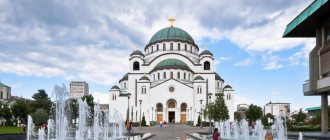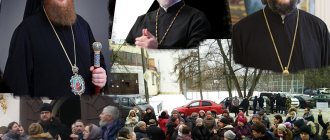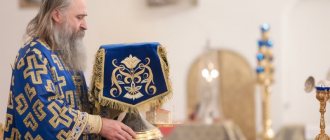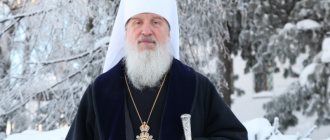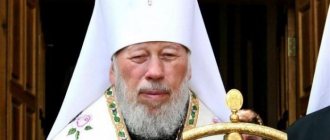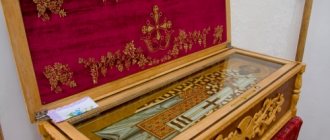| Metropolitan Barsanuphius (Sudakov) |
Barsanuphius (Sudakov)
(born 1955), Metropolitan of St. Petersburg and Ladoga, head of the St. Petersburg Metropolis, permanent member of the Holy Synod of the Russian Orthodox Church, member of the Presidium of the Inter-Council Presence of the Russian Orthodox Church, Chairman of the Commission on Church Administration and Mechanisms for the Implementation of Conciliarity in the Inter-Council Church presence, member of the Commission on the Organization of the Life of Monasteries and Monasticism of the Inter-Council Presence, member of the Supreme Church Council of the Russian Orthodox Church In the world Anatoly Vladimirovich Sudakov, was born on June 3, 1955 in the village of Malinovka, Arkadak district, Saratov region, into a large peasant family. He received his initial religious education from his mother Antonina Leontievna Sudakova-Pozorova, who was distinguished by her particular piety.
In 1972 he graduated from Malinovskaya secondary school and for a year worked in his village as a postman and at a brick factory.
In the fall of 1973, he was drafted into the army and sent to a group of Soviet forces in Germany, where he served as a mechanic-driver of medium tanks in the military units of Brandenburg and Potsdam.
In November 1975, after demobilization from the army, he got a job as an altar boy at the Archangel Michael Cathedral in the city of Serdobsk, Penza region, where the rector was one of the most prominent clergy of the Penza and Saransk diocese, Archimandrite Modest (Kozhevnikov).
In 1976 he entered the Moscow Theological Seminary and successfully graduated in 1979, in three years instead of four. Already at the seminary, he finally decided to connect his fate with monasticism: in October 1977, he was accepted as a novice into the brotherhood of the Trinity-Sergius Lavra.
On March 30, 1978, he was tonsured a monk by the abbot of the Lavra, Archimandrite Jerome (Zinoviev), and named in honor of St. Barsanuphius, Bishop of Tver. On April 27 of the same year, Archbishop Vladimir of Dmitrov was ordained to the rank of hierodeacon, on November 26, 1978, by him to the rank of hieromonk, and in 1982 he was elevated to the rank of abbot.
At the Lavra he had a close friendship with the confessors of the monastery, Archimandrites Kirill (Pavlov) and Naum (Baiborodin). His immediate spiritual superiors were the sacristan Archimandrite Aristarchus (Stankevich); dean, and then viceroy, Archimandrite Eusebius (Savvin); Dean Archimandrite Mark (Petrovtsy). They largely determined and influenced his life path.
From 1978 to 1982 he was assistant sacristan, and from 1982 to 1986 he was assistant dean.
From 1982 to 1986 he studied at the Moscow Theological Academy, defended his dissertation for the degree of candidate of theology. The head of the scientific work was Archimandrite Innokenty (Prosvirnin). The topic of scientific research was Mount Athos.
After graduating from the academy, he was sent to pastoral service in the Penza diocese at the request of Bishop of Penza and Saransk Seraphim (Tikhonov).
From September 15, 1986 to June 15, 1988 - rector of the Kazan Church in the city of Kuznetsk, Penza region.
In 1987 he was elevated to the rank of archimandrite.
From June 15, 1988 to February 7, 1991 - rector of the Assumption Cathedral in the city of Penza, secretary of the Penza diocesan administration. His spiritual mentor during these years was Archbishop of Penza and Saransk Seraphim (Tikhonov).
In 1988 and 1990 he was a participant in the Local Councils of the Russian Orthodox Church.
On January 29-31, 1991, by resolution of the Holy Synod, he was determined to be the bishop of the newly formed Saransk diocese.
On February 8 of the same year, he was consecrated Bishop of Saransk and Mordovia. The ordination in the Moscow Epiphany Cathedral was led by Patriarch Alexy II of Moscow and All Rus'.
On February 15 of the same year he arrived in Saransk.
From July 3 to December 28, 2000, he temporarily ruled the Penza diocese [1].
| Archbishop Barsanuphius (Sudakov) |
On February 22, 2001, he was elevated to the rank of archbishop.
On March 31, 2009, he was appointed acting manager of the affairs of the Moscow Patriarchate, a permanent member of the Holy Synod ex officio. On December 25 of the same year, he was confirmed as manager of the affairs of the Moscow Patriarchate.
From May 27, 2009 to 2013 - Chairman of the newly formed Award Commission under the Patriarch of Moscow and All Rus' [2].
On July 27, 2009, he became a member and presidium of the Inter-Council Presence of the Russian Orthodox Church. Since January 29, 2010 - Chairman of the Commission on Issues of Church Administration and Mechanisms for the Implementation of Conciliarity in the Church, Member of the Commission on Issues of Organizing the Life of Monasteries and Monasticism of the Inter-Council Presence [3].
On February 1, 2010, he was elevated to the rank of metropolitan.
On March 22, 2011, he became a member of the newly formed Supreme Church Council of the Russian Orthodox Church [4] ex officio.
On October 6, 2011, he was appointed head of the Mordovian Metropolis.
On October 4, 2012, he was confirmed as the holy archimandrite of the Saransk St. John the Theological Monastery [5].
On March 19, 2014, he was transferred to the St. Petersburg and Ladoga See and appointed head of the St. Petersburg Metropolis, a permanent member of the Holy Synod with temporary retention of the post of manager of the affairs of the Moscow Patriarchate [6].
On February 26, 2021, he was relieved of his post as manager of the affairs of the Moscow Patriarchate [7].
Essays
- Barsanuphius, Bishop of Saransk and Mordovia. Essays. - In 5 t.
- v.1. Return from oblivion. Reports, articles, speeches, appeals, interviews. - Saransk, 1995, 248 pp.;
- v.2. An exhortation to spiritual correction. Messages, sermons, teachings. - Saransk, 1995, 228 pp.;
- v.3. Athos in the life of the Russian Orthodox Church in the 19th - early 20th centuries. - Saransk, 1995, 176 pp.;
- v.4. Conviction of truth. Sermons. - Saransk, 1995, 200 pp.;
- v.5. Lessons of a grace-filled life. Sermons. - Saransk, 1996, 216 p.
He is also the author of numerous articles and messages.
Childhood and youth
In the summer of 1955, another boy was born into the peasant family of the Sudakovs in the Saratov region, the village of Malinovka, who was named with the sonorous name Anatoly. The family was very devout; their mother, Antonina Leontyevna, especially carefully raised their children in the Orthodox faith, regularly taking them to church and giving the children a primary church education.
The Sudakovs were raised simply in the family, taught to work from an early age, so immediately after graduating from secondary school in 1972, Anatoly worked in the village as a postman, while working part-time at a brick factory.
The youth of the future metropolitan came at a time of new repressions in the USSR regarding the Orthodox Church - Nikita Khrushchev, who came to power, launched a new wave of oppression and arrests of priests, hoping to completely destroy Christianity in the country.
Nevertheless, Anatoly grew up as a believing young man, although he went to serve his military service - in 1973-1975. he served in the German Democratic Republic as a tank driver and mechanic.
Awards
Church:
- memorial patriarchal panagia (2000, from Patriarch Alexy II)
- memorial patriarchal panagia (April 24, 2013, from Patriarch Kirill in honor of the name day and the 35th anniversary of service in the priesthood) [8]
- patriarchal charter
- medal of St. Sergius of Radonezh 1st, 2nd and 3rd degree
- Order of Equals book Vladimir III degree
- Order of the Blessed Prince Daniil of Moscow II degree (2008)
- Order of St. Sergius of Radonezh, 1st degree (2012) [9]
Secular:
- Certificate of honor of the Republic of Mordovia
- Russian State Order of Friendship (2002)
- medal "300 years of the Russian Navy"
- Medal "For Merit in Conducting the All-Union Population Census"
- Order of Merit, 3rd degree (2013, Ukraine, in honor of the 1025th anniversary of the Baptism of Rus) [10]
Metropolitan Barsanuphius serves in the army and enters theological seminary
The period of restoration of the Soviet Union after the end of World War II can be called truly difficult. The western part of the country was literally rebuilt from ruins. And even in 1955, echoes of this terrible period of time were still heard in remote villages and villages.
It was in such a village that on June 3, 1955, a boy was born, who in the future became the ruler of the St. Petersburg and Ladoga Metropolis. The holy father's family could boast of having many children. He grew up surrounded by many brothers and sisters.
Anatoly’s mother, Antonina Sudakova-Pozorova, had a huge influence on the future. From an early age, she instilled in her children a love for the church and even gave them a primary church education. At the same time, Anatoly received a regular school education, and after finishing school, the young man immediately began working to help his family.
At that time, Anatoly was only seventeen years old, and he had already worked as a postman in the village and as a worker at a brick factory.
2018
this year Barsanuphius is not allowed to go to Mount Athos
A year later, in 1973, when Anatoly turned eighteen, he was drafted into the army. I must say that he was lucky - he was sent to serve in the German Democratic Republic.
The conditions of service in the GDR were strikingly different from those in the outback of the Far East or the deserts of Central Asia. Anatoly served the required two years in the tank forces, being a tank driver. So the young man visited the cities of Potsdam and Brandenburg. In 1975, he was demobilized and sent home to his native village.
Creation of new dioceses
The service of Metropolitan Barsanuphius as the head of the Saransk diocese was marked by the creation of two new church-administrative entities separated from its composition. They became the Krasnoslobodsk and Ardatov dioceses. Guided by his deep knowledge of the specifics of the work entrusted to him, the bishop repeatedly pointed out that in order to carry out effective management, no more than one hundred and fifty parishes should be subordinate to the diocesan bishop, since a larger number makes it difficult for attentive and consistent leadership.
His initiative was approved by the members of the Holy Synod and led to corresponding structural changes. At the same time, Metropolitan Barsanuphius was appointed acting head of the newly created Mordovian Metropolis.
Bishop Barsanuphius serves in churches of the Russian Orthodox Church
Just a month later, the monk Varsinaphius received the next rank and became a hierodeacon. And in the fall of 1978 he was ordained to the rank of hieromonk. It is worth noting that in 1977 he entered the Moscow Theological Seminary and in 1979 he successfully graduated from it in just three years, instead of the usual four.
Having received the rank of hieromonk, Sudakov continues to serve in the Lavra and is engaged in the duties of an assistant sacristan. This continues until 1982.
Barsanuphius defended his dissertation “Athos – the great treasury of Orthodoxy.”
In 1982, Sudakov was ordained to the rank of abbot (rector of a temple or monastery). At the same time, he entered the Moscow Theological Academy to receive higher theological education. The holy father studied there until 1986.
MDA students were entitled to vacation leave. Father Barsanuphius, during his forced leave, went to the Pyukhtitsa convent, which stood in Estonia. Here he served under Metropolitan Alexy and Abbess Varvara.
After graduating from the Moscow Theological Academy, he did the following:
- 1986 - 1988 - hegumen in the Kazan Church in the city of Kuznetsk, in the Penza region;
- 1987 - ordained to the rank of archimandrite;
- 1988 - 1991 - served as rector at the Assumption Church in the city of Penza;
- 1988 and 1990 - participant of the Local Council.
In the circle of wise mentors
Fulfilling the obediences assigned to him in the Trinity-Sergius Lavra, the future Metropolitan Barsanuphius relied in his works on the advice of wise mentors. Among them were the Lavra’s confessors, Archimandrites Naum and Kirill, the Lavra’s governor, Archimandrite Eusebius (Savvin), and many other people who shared their spiritual experience with him.
He also had to communicate closely with the future Patriarch of All Rus', and in those years Metropolitan of Tallinn and Estonia Alexy (Ridiger). Hegumen Barsanuphius met with him, and even ministered to him several times during his visits to the Pukhtitsky monastery in Estonia, where he regularly visited during the holidays.
Elevation to the rank of metropolitan
The next important stage on the path of the bishop’s episcopal service was his appointment to the position of manager of the affairs of the Moscow Patriarchate, and confirmation as a permanent member of the secretary of the Holy Synod. In connection with February 1, 2010, by patriarchal decree, Archbishop Barsanuphius was elevated to the rank of metropolitan.
A year earlier, he was entrusted with heading the Awards Commission, created shortly before under the Patriarch of Moscow and All Rus'. Metropolitan Barsanuphius performed this honorable duty until 2013.
St. Barsanuphievsky Convent
Saint Barsanuphius, Bishop of Tver, wonderworker of Kazan, was born around 1495 in the city of Serpukhov in the family of priest Vasily. At baptism the baby received the name John. Distinguished by his diligence and understanding, the youth easily mastered reading and writing, mastered reading the Psalter and church singing.
In 1512, the Crimean Tatars, led by the sons of Mengli Giray - Akhmat Giray and Burnat Giray (Burnasha), went on a campaign against Ryazan, but “without having time to capture the city of Ryazan” they carried out a quick and unexpected devastating campaign along the banks of the Oka. Among the many captured was seventeen-year-old John. The situation of the prisoner was bitter, but prayer eased his grief and brought such consolation to his heart that he did not feel in his parental home. Love for God grew in him, and with it devotion to His holy will. John worked as an infidel with all zeal and learned unrequited obedience, patience and kindness. The fast, at first involuntary, turned into a matter of his good will. Tiring work occupied him all the time of the day, and he devoted the night to prayer, which became the need of his soul. With his zeal and meekness, John won over the hardened hearts of the Gentiles, who began to treat him softer and more condescending than others. Gradually, thanks to his extraordinary abilities, he mastered the spoken Tatar language to such an extent that after two years he could not only speak well, but also write in Tatar. He studied the Mohammedan faith so that he could clearly speak both about the content of this faith and about its errors. A thorough knowledge of the language and faith of the Tatars fulfilled the wise purpose for which the Lord allowed His servant to be in captivity.
The captivity lasted three years. With great difficulty, having collected the necessary amount, priest Vasily ransomed his son from Tatar captivity.
Returning home, according to a vow made while still in captivity, he went to Moscow, where he took monastic vows at the Spaso-Andronikov Monastery. Three years of captivity replaced the novice experience for him. Renouncing the world, the monk dies for it and is born into a new life, which is why he is given a new name. The newly tonsured monk was named Barsanuphius. Saint Akakios, Bishop of Tver (1522-1567), brother of the Venerable Joseph of Volotsk, a kind and pious archpastor, visited the Andronikov Monastery. Bishop Akakios, “a shepherd possessed of spiritual insight, had repeatedly predicted to Saint Barsanuphius for a very long time, and precisely during his hierodeaconship, that he would take his place in Tver and would govern the people of God in it.”
Probably, from Akaki, the virtuous and pious life of the Monk Barsanuphius became known to Metropolitan Macarius of Moscow, who elevated Saint Barsanuphius to the rank of abbot of the Nikolo-Peshnoshskaya Methodius Hermitage. Founded in 1361 by a student of St. Sergius of Radonezh by the Monk Methodius in the wilderness 25 versts from Dmitrov on the right bank of the Yakhroma River at the confluence of the Peshnosha River; in ancient times this desert was called “Nikola on Pesnusha”.
In 1553, on the way to the Kirillo-Belozersky Monastery, the Peshnosha monastery was visited by Tsar Ivan the Terrible, who was making a pilgrimage in gratitude for his miraculous deliverance from death. He drew attention to an experienced mentor of monastic life, who had been in captivity and knew the Tatar language and customs of this people. Therefore, when Kazan submitted to Tsar Ivan Vasilyevich and a new diocese was formed, then, together with Saint Gury, the first Archbishop of Kazan, by decree of the tsar, Archimandrite Barsanuphius was sent to Kazan to found a monastery. On the Sunday of the Holy Fathers, May 26, 1555, with the ringing of all the Kremlin bells, Metropolitan Macarius with Bishop Niphon of Krutitsa and all the archimandrites of Moscow and abbots, as well as Saint Gury with his archimandrites and the consecrated clergy, in the presence of the king and the entire synclite, served Farewell prayer service in the Assumption Cathedral. At the end of which the high priests of Kazan solemnly set off on a journey that lasted two months.
On Sunday, July 27, 1555, Saint Gury with Archimandrite Barsanuphius and the abbot of the Assumption Staritsky Monastery German and the monks of the Peshnoshsky and Andronikov monasteries arrived in Kazan. They were greeted with crosses and banners at the Kazan Annunciation Cathedral. Already in the next 1556, the Monk Barsanuphius fulfilled the assignment entrusted to him, establishing the Transfiguration Monastery in the Kazan Kremlin. He consecrated both the first stone church of the monastery in the name of St. Nicholas the Ratnoy, and the main church in honor of the Transfiguration of the Lord. In the monastery charter, written by Archimandrite Barsanuphius himself, he calls himself “the many-sinful monk who was the abbot of Pesnosha.” Secretly from everyone, he continued to wear chains to wear out his flesh. The monastery soon became the center of spiritual life in Kazan. A few years later the number of monks in it reached one hundred people. His ability to treat illnesses attracted sick people of all kinds to him. By the will of Saint Gurias, to whom he maintained complete obedience and filial love, Saint Barsanuphius zealously worked to convert the Mohammedans to the Christian faith. On December 2, 1563, Saint Barsanuphius was tonsured into the great schema, and on December 4, he buried the body of his closest friend and mentor, Saint Gury, Archbishop of Kazan. After the death of Bishop Akakios of Tver (+1567), Saint Philip, Metropolitan of Moscow, summoned Saint Barsanuphius to Moscow and elevated him to the rank of Bishop of Tver.
Saint Barsanuphius was a true lamp for his flock, not with words alone, but with his whole life, pointing out the saving path of Christ. Despite his high priestly rank, he continued to be a humble ascetic, as he was both in the Peshnosh monastery and in Kazan. He spent his nights in prayer, his days in work and worries. While resting, he sewed hoods for the brethren, and with unceasing prayer he healed the physical and mental illnesses that turned to him. In 1567, Saint Barsanuphius consecrated one of the 5 stone cathedrals of the Tver land of that time - the majestic cathedral Church of the Ascension of the Lord of the ancient Orshina Monastery.
In difficult times, the Lord destined him to rule the Tver flock. Tsar Ivan the Terrible became a horror and a scourge for his subjects, instilling the “oprichnina.” Tver did not belong to the oprichnina and therefore did not enjoy the favor of the tsar. With pain and indignation, Saint Barsanuphius saw how his friend, Archbishop German, summoned from Kazan to Moscow to be elevated to the rank of metropolitan, was expelled and died in captivity after he meekly reminded the tsar of his responsibility for cruelty at the court of God. Many terrible events took place before the eyes of Saint Barsanuphius during the four years of his episcopal service. It was in Tver, in sight of its chambers, across the Volga, that its holy ordainer, Metropolitan Philip, was strangled in the Otroche Monastery, and no one dared to give news of this to Saint Barsanuphius. At the same time, a terrible pestilence devastated Tver and Moscow. In one monastery of Joseph Volotsky, up to three hundred brethren died, not counting the laity. Many villages and cities were deserted; churches stood without priests and without services, there was no one to bury the dead; famine and drought completed the disaster. Saint Barsanuphius deeply grieved for his flock.
Feeling the infirmity of old age, in 1571 he retired to the monastery he founded in Kazan. He spent five years in the Transfiguration Monastery, in prayer and solitude, where, according to 19th-century sources, he received the great schema. When, due to weakness, he could no longer go to church himself, loving disciples brought him to the temple of God, knowing his love for worship. Saint Barsanuphius died on April 11, 1576 and was buried in the Transfiguration Monastery by Archbishop Tikhon of Kazan.
By order of Tsar Theodore Ioannovich, the monastery began to build a stone church in honor of the Transfiguration of the Lord on the site of a wooden one. During the construction of the temple in 1595, the relics of the Kazan saints Guria and Barsanuphius were discovered. A description of the discovery of the relics was made by an eyewitness, the future Patriarch Hermogenes, at that time the Archbishop of Kazan. “When, on October 4, they reached the tombs of the holy fathers, they came to tell me, the humble one, about this. Having brought a bloodless sacrifice to the Lord God with the entire consecrated cathedral and sang a requiem mass, we went to the monastery and, having arrived at the place, bowed to the tombs of the monks Father Guria and Barsanuphius. Having opened the coffin, we saw something completely unexpected: the saint’s shrine was full of fragrant myrrh, and the relics of Saint Guria were floating like a sponge on top of the world; no part was submerged. God endowed his honest and laborious body with incorruption, as everyone sees it even now... I, unworthy, with a sinful hand touched the holy body, touched the vestments in which he was buried, and they were very strong. I tried to forcefully pull his mantle and other funeral clothes, and they seemed stronger than new ones. In the chapters of the Monk Gury lay a Greek knitted hood, which, according to the legend of the disciples of St. Barsanuphius, was made by the Monk Barsanuphius for Gury, and after the death of the saint was placed unfinished at the head of his tomb. We collectively examined this hood and, taking a strand from it, we could hardly tear it, because it was stronger than new. We poured the fragrant myrrh into a new vessel, and Orthodox Christians, using that world, continually received healings. Then we opened the shrine of Barsanuphius and saw that his relics were honored by God with incorruptibility... which we verified by transferring the holy and miraculous relics of both with our own hands with Archimandrite Arseny from the coffins into the arks. Marveling at the ineffable love of God, we sang funeral songs over the reverend fathers with tears and meekness and placed them on top of the ground, so that everyone who came could see them and, marveling, glorify God.”
Saints Gury and Barsanuphius were canonized by decree of Patriarch Job. Their first life was compiled by Patriarch Hermogenes, and the text of the service to the saints was written by Demetrius of Rostov. The relics of St. Barsanuphius were in the Transfiguration Cathedral until 1918, and then were transferred to the Kazan Mother of God Monastery, which was closed in 1929. Since that time, the location of the relics of St. Barsanuphius of Tver remains unknown; details of his reliquary have been preserved in the National Museum of the Republic of Tatarstan.
Troparion to Saint Barsanuphius, Bishop of Tver Troparion, tone 3:
Pray to the proclaimer of the path of salvation, true keeper of the apostolic traditions, unshakable pillar, teacher of piety and Orthodoxy, Saint Barsanuphius, Lord of all, to grant greater peace to our souls and great mercy.
Troparion, tone 4:
Guided by the quietness of your disposition, Saint Barsanuphius, you reached a quiet refuge, for the sake of humility, conveniently escaping the opposing snares, with your holy soul you flew to Heaven, where Christ stands before us, pray that we who honor your memory will be saved.
Troparion, tone 8:
According to God's law, a zealot, a fierce destroyer of hostile flattery, as if in peace, then with his labors and vigils he labored in the midst of the Kazan kingdom, the monastery of the building of the magnificent Transfiguration and following his great teacher Guria, with him having a great spiritual union, as in the stomach, and also after repose God glorified you with the discovery of your honorable relics at one time and with many miracles; and, joyfully ascending into the Heavenly abodes, solid in the stone of faith, you endured many sorrows from a foreigner, good guide into eternal life, in the wilderness, we pray to you, lead us in, O Reverend Father Barsanuphius, and pray to Christ God to save our souls.
Kontakion, tone 6:
Having enslaved the body to the spirit through abstinence, you created the soul equal to the angels, for this, for the sake of holiness, you honored the rank of purity, the purest one. Pray to Christ God, the saint, to save your people, holy one, and let us all cry out to you: Rejoice, Father Reverend Barsanuphius, praise and affirmation to our city of Kazan.
Kontakion, tone 5:
Like an all-bright star, shining with virtues, you were, enriching yourself with prayer and fasting, and depressing your body with chains, but in the fullness of the foreigner you suffered a lot. Unshakable in faith for many years, united by an angel, the demonic militia grieves you. Following the unmercenary Cosmas and Damian, you healed many with medical cunning. Moreover, now your honest and God-labored body, acquired from the bowels of the earth, the Lord glorified miracles, for you healed the many sick not only at the grave, but also from honest faiths, giving endless healing gifts to those who come with faith.
Greatness
We magnify you, Holy Hierarch Father Barsanuphius, and honor your holy memory, for you pray for us to Christ our God.
Anatoly becomes a monk
The young man did not stay long in his native village and immediately went to work in the church. Already possessing a basic church education, he easily gets a job as an altar boy in the Church of the Archangel Michael in the city of Serdobsk, in the Penza region.
Anatoly works a lot and diligently, and shows interest in services. Seeing this, the rector of the temple, Archimandrite Modesta, advises the young man to receive a deeper spiritual education. Sudakov takes the priest’s advice and decides to become a monk and receive a secondary church education.
Assumption Cathedral in the city of Penza. For three years it was led by Father Barsanuphius
In 1976, Anatoly prepared the necessary documents and entered the Moscow Theological Seminary. Here he is completely imbued with the atmosphere of the educational institution and makes the final decision to become a monk. Here he will study for the next two years and, having received a diploma, will go to the place of his first obedience.
The young man was accepted into the service of the brotherhood of the Tritsko-Sergius Lavra. Until March 30, 1978, he served as a simple monk, but it was on this date that one of the most important events in Anatoly’s life happened. Archimandrite of the Lavra Jerome personally tonsured him as a monk. From then on, Anatoly was given the church name Barsanuphius, in honor of the saint and bishop of Tver Barsanuphius.
